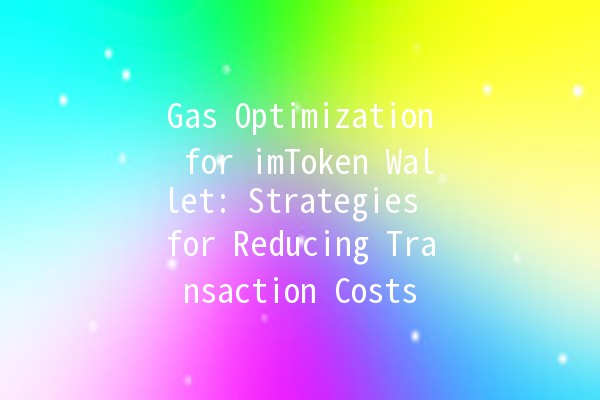In the world of cryptocurrency, transaction costs can accumulate rapidly, especially when dealing with Ethereumbased tokens through wallets like imToken. Understanding how to optimize gas fees is crucial for users seeking to minimize their expenditure. This article provides practical tips and strategies to help you effectively manage gas fees when using the imToken wallet.
Gas fees are essentially the costs required to execute transactions or smart contracts on the Ethereum blockchain. Each operation performed on the network consumes a certain amount of gas, which is then paid in Ether (ETH). High network demand can drive these fees up, making it essential for users to adopt strategies for reducing costs.
Gas optimization not only saves money but also ensures that transactions are processed efficiently. By applying various techniques, users can avoid excessive fees during periods of high congestion and enhance their overall experience with the imToken wallet.
Staying informed about current gas prices is the first step toward effective gas optimization. There are several tools available that provide realtime gas price data, such as Etherscan and Gas Station. By monitoring these sources, you can identify the optimal time to make transactions when gas fees are lower.
Example: If you notice that the gas price is significantly lower on a weekend, consider postponing your transactions until then. This simple change can reduce costs without additional effort.

imToken allows users to manually adjust gas limits and prices for their transactions. Understanding how these parameters work can significantly impact your transaction costs.
Gas Limit: This is the maximum amount of gas you are willing to use for your transaction. Setting it too high can result in overpaying for a transaction that doesn't require as much gas.
Gas Price: This is the fee you are willing to pay per unit of gas. By reducing the gas price slightly, your transaction may take a bit longer to confirm, but you'll save money.
Example: If the recommended gas price is 100 Gwei, try setting yours at 80 Gwei. This may lead to a longer wait time, but can result in substantial savings over multiple transactions.
Layer 2 solutions are protocols built on top of the Ethereum blockchain that offer scalability and lower transaction fees. Utilizing solutions such as Polygon or Optimism can help you execute transactions with reduced gas costs.
Example: Consider transferring tokens via a Layer 2 solution to access significantly lower gas fees compared to operating directly on Ethereum's mainnet. This could mean the difference between paying $5 to $10 or just a few cents.
If you frequently conduct multiple transactions, consider batching them into a single transaction. This technique consolidates gas usage and can lead to considerable savings.
Example: Instead of sending five separate transactions to different recipients, combine them into one single transaction. This will reduce the total gas consumption and the fees incurred, potentially saving you a large sum over time.
Ethereum's network conditions can fluctuate, impacting gas prices. Understanding when the network is most congested can help you plan your transactions more effectively.
Example: During major announcements or events, such as NFT drops or DeFi launches, the Ethereum network often experiences spikes in activity. Avoid transacting during these times to sidestep high gas fees.
The imToken wallet is a powerful tool for managing cryptocurrency transactions. By implementing the strategies outlined above, users can effectively optimize their gas fees and maximize their savings. Whether you're a seasoned trader or a casual user, understanding gas optimization is key to enhancing your cryptocurrency journey.
Gas is the fee users pay to miners for processing transactions or executing smart contracts on the Ethereum blockchain. It compensates for the computational effort required to validate transactions.
You can check platforms like Etherscan and Gas Station for realtime gas price information. These tools provide insights into current network conditions and help you determine the best time to transact.
Unfortunately, gas fees are nonrefundable. If your transaction fails, you still pay for the gas used during the attempted execution. Always ensure that your transaction parameters are correctly set to minimize failures.
If your transaction is timesensitive, paying higher gas fees can be beneficial. However, weigh this against the potential savings by waiting for lower gas prices, especially for nonurgent transactions.
Layer 2 solutions enhance transaction speeds and lower costs by executing transactions off the main Ethereum blockchain. They facilitate quicker transactions with significantly reduced gas fees.
While the concepts are applicable across different Ethereum wallets, specific implementations may vary. Each wallet has its own interface for managing gas settings, but the underlying principles remain the same.
By incorporating these strategies, you can make the most of your time and resources while using the imToken wallet, allowing you to focus on your cryptocurrency investments rather than worrying about gas fees.